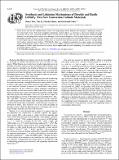| dc.contributor.author | Twu, Nancy H. | |
| dc.contributor.author | Li, Xin | |
| dc.contributor.author | Moore, Charles Jacob | |
| dc.contributor.author | Ceder, Gerbrand | |
| dc.date.accessioned | 2014-11-20T19:19:41Z | |
| dc.date.available | 2014-11-20T19:19:41Z | |
| dc.date.issued | 2013-09 | |
| dc.date.submitted | 2013-07 | |
| dc.identifier.issn | 0013-4651 | |
| dc.identifier.issn | 1945-7111 | |
| dc.identifier.uri | http://hdl.handle.net/1721.1/91662 | |
| dc.description.abstract | Driven by the need for new cathode battery materials with high energy density, fluorides have emerged as promising candidates due to their high voltages. From high throughput computations, dirutile LiMnF4 was identified as a promising cathode with a high conversion voltage and a theoretical specific capacity of 584 mAh/g. In this work, we study the formation of dirutile LiMnF4 through a new, low-temperature synthesis route and report its electrochemical properties. We also report the discovery of a new rutile polymorph of LiMnF4 which has Li-Mn disorder on the cation site. Electron diffraction confirmed both dirutile and rutile LiMnF4 to convert upon lithiation with different reaction paths. As seen with other fluoride materials, specific capacity is strongly linked with synthesis and processing conditions. With LiMnF4, there was a tradeoff in maintaining phase-pure samples and optimizing samples for high specific capacity. Still, even with very simple synthesis and electrode preparation methods, both rutile and dirutile polymorphs of LiMnF4 show electrochemical activity. Further optimization of particle morphology may enhance reaction kinetics and improve specific capacity. | en_US |
| dc.description.sponsorship | National Science Foundation (U.S.) (Graduate Research Fellowship) | en_US |
| dc.description.sponsorship | Robert Bosch GmbH | en_US |
| dc.description.sponsorship | Umicore Specialty Oxides and Chemicals | en_US |
| dc.description.sponsorship | University of Texas at Austin. Texas Advanced Computing Center | en_US |
| dc.description.sponsorship | National Science Foundation (U.S.) (grant number TG-DMR970008S to TeraGrid Project) | en_US |
| dc.language.iso | en_US | |
| dc.publisher | Electrochemical Society | en_US |
| dc.relation.isversionof | http://dx.doi.org/10.1149/2.022311jes | en_US |
| dc.rights | Article is made available in accordance with the publisher's policy and may be subject to US copyright law. Please refer to the publisher's site for terms of use. | en_US |
| dc.source | MIT web domain | en_US |
| dc.title | Synthesis and Lithiation Mechanisms of Dirutile and Rutile LiMnF4: Two New Conversion Cathode Materials | en_US |
| dc.type | Article | en_US |
| dc.identifier.citation | Twu, N., X. Li, C. Moore, and G. Ceder. “Synthesis and Lithiation Mechanisms of Dirutile and Rutile LiMnF4: Two New Conversion Cathode Materials.” Journal of the Electrochemical Society 160, no. 11 (January 1, 2013): A1944–A1951. © 2013 The Electrochemical Society. | en_US |
| dc.contributor.department | Massachusetts Institute of Technology. Department of Materials Science and Engineering | en_US |
| dc.contributor.mitauthor | Twu, Nancy H. | en_US |
| dc.contributor.mitauthor | Li, Xin | en_US |
| dc.contributor.mitauthor | Moore, Charles Jacob | en_US |
| dc.contributor.mitauthor | Ceder, Gerbrand | en_US |
| dc.relation.journal | Journal of the Electrochemical Society | en_US |
| dc.eprint.version | Final published version | en_US |
| dc.type.uri | http://purl.org/eprint/type/JournalArticle | en_US |
| eprint.status | http://purl.org/eprint/status/PeerReviewed | en_US |
| dspace.orderedauthors | Twu, N.; Li, X.; Moore, C.; Ceder, G. | en_US |
| dspace.mitauthor.error | true | |
| mit.license | PUBLISHER_POLICY | en_US |
| mit.metadata.status | Complete | |
